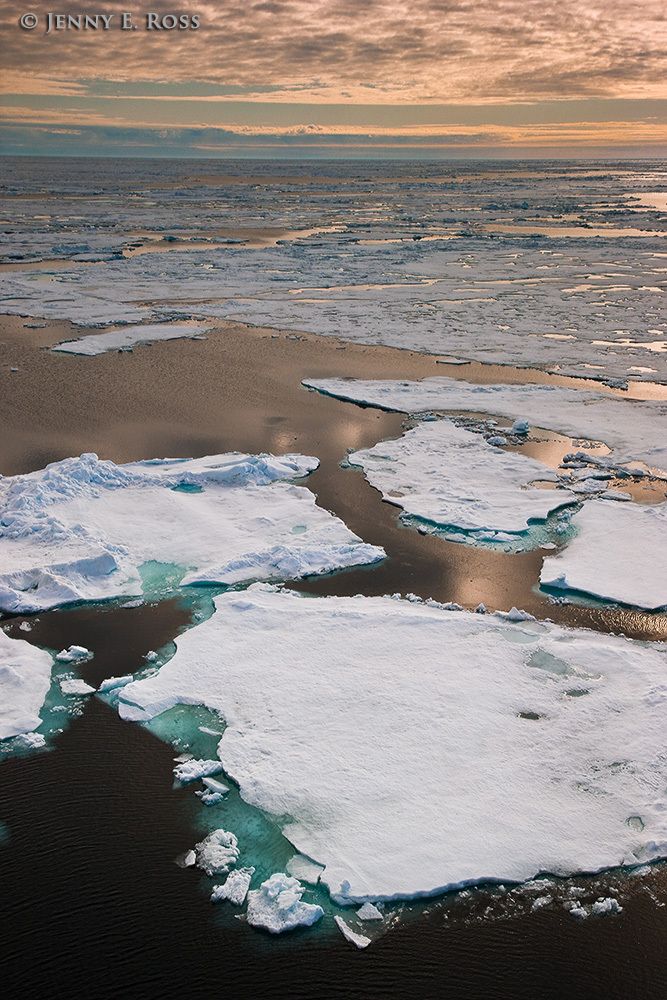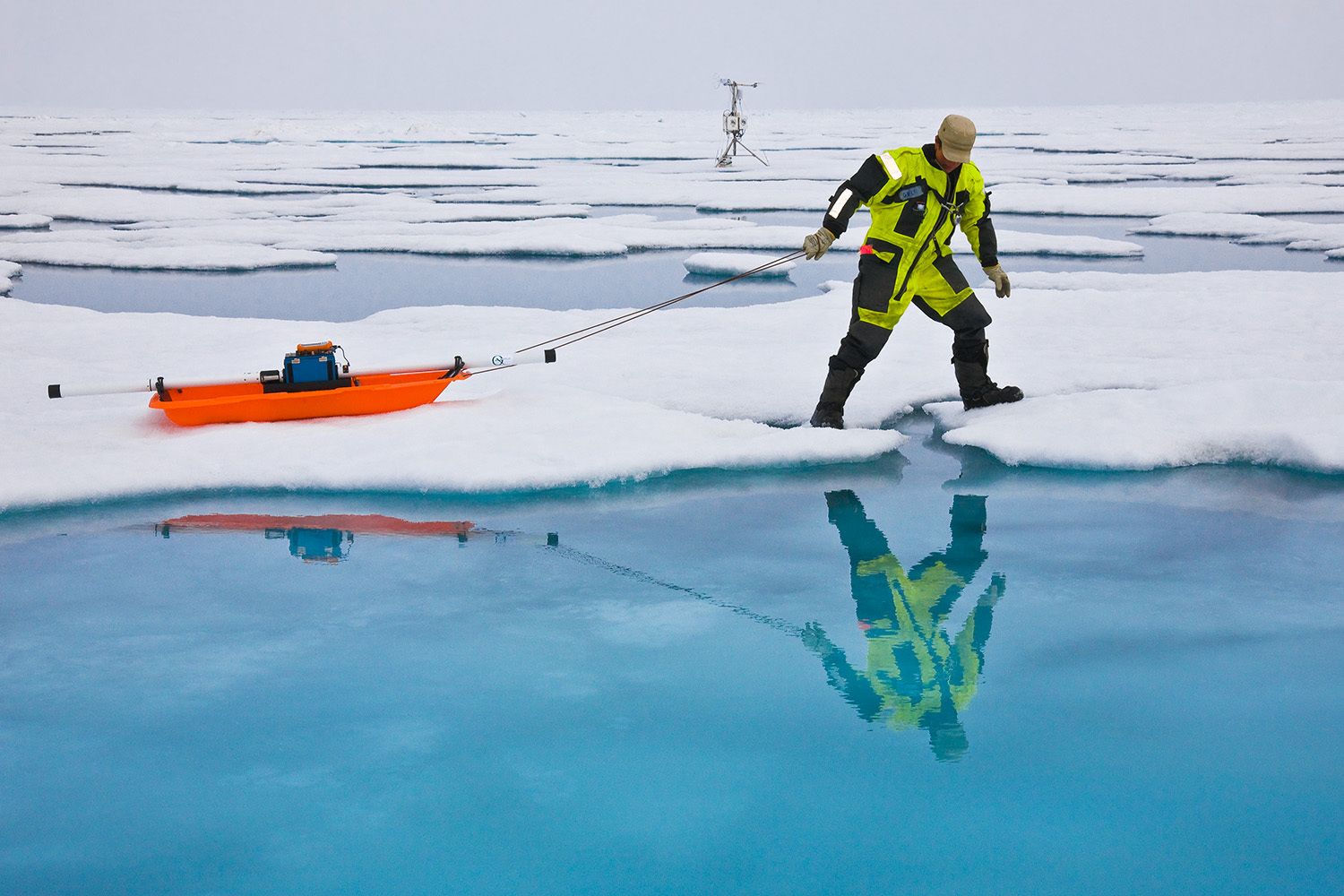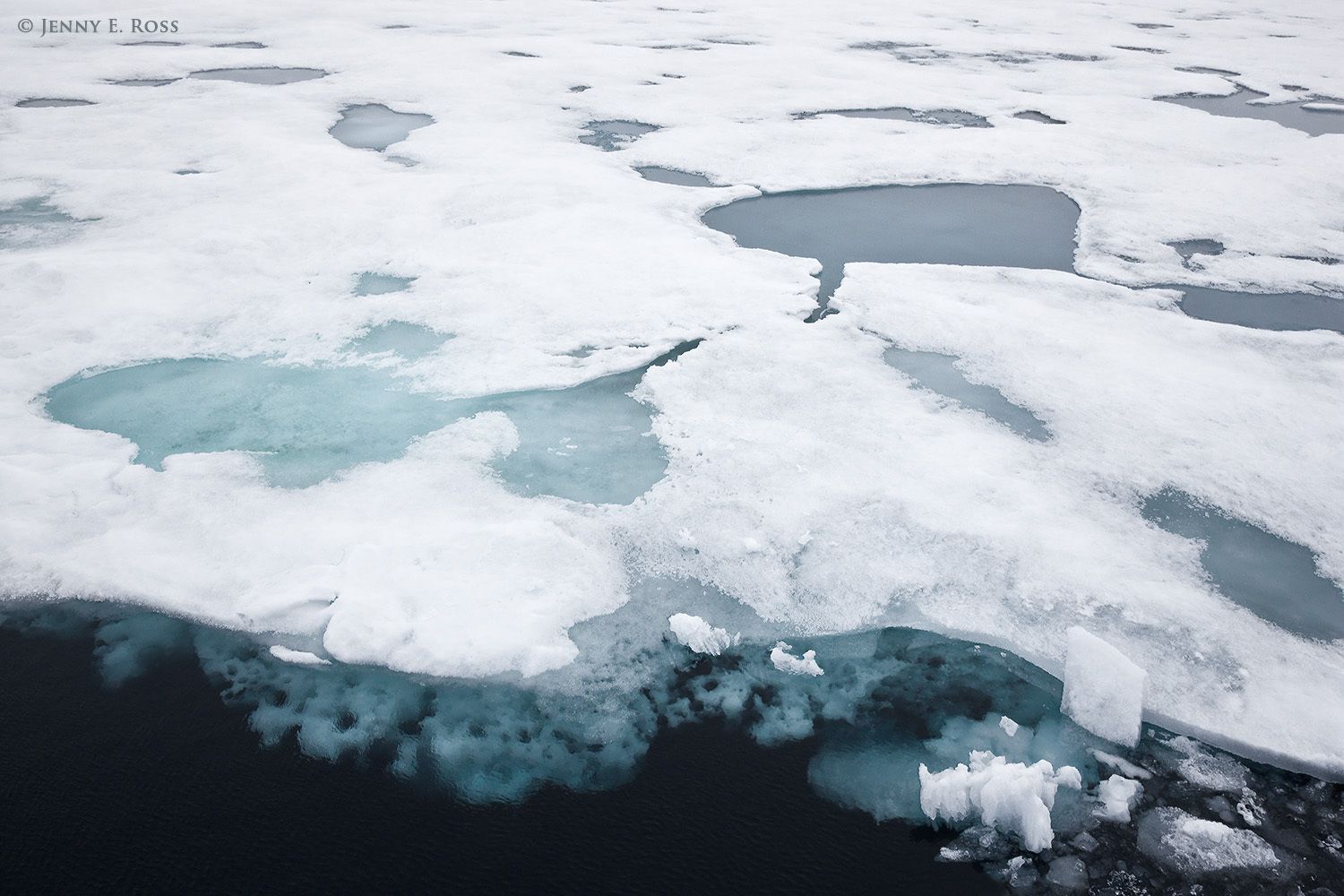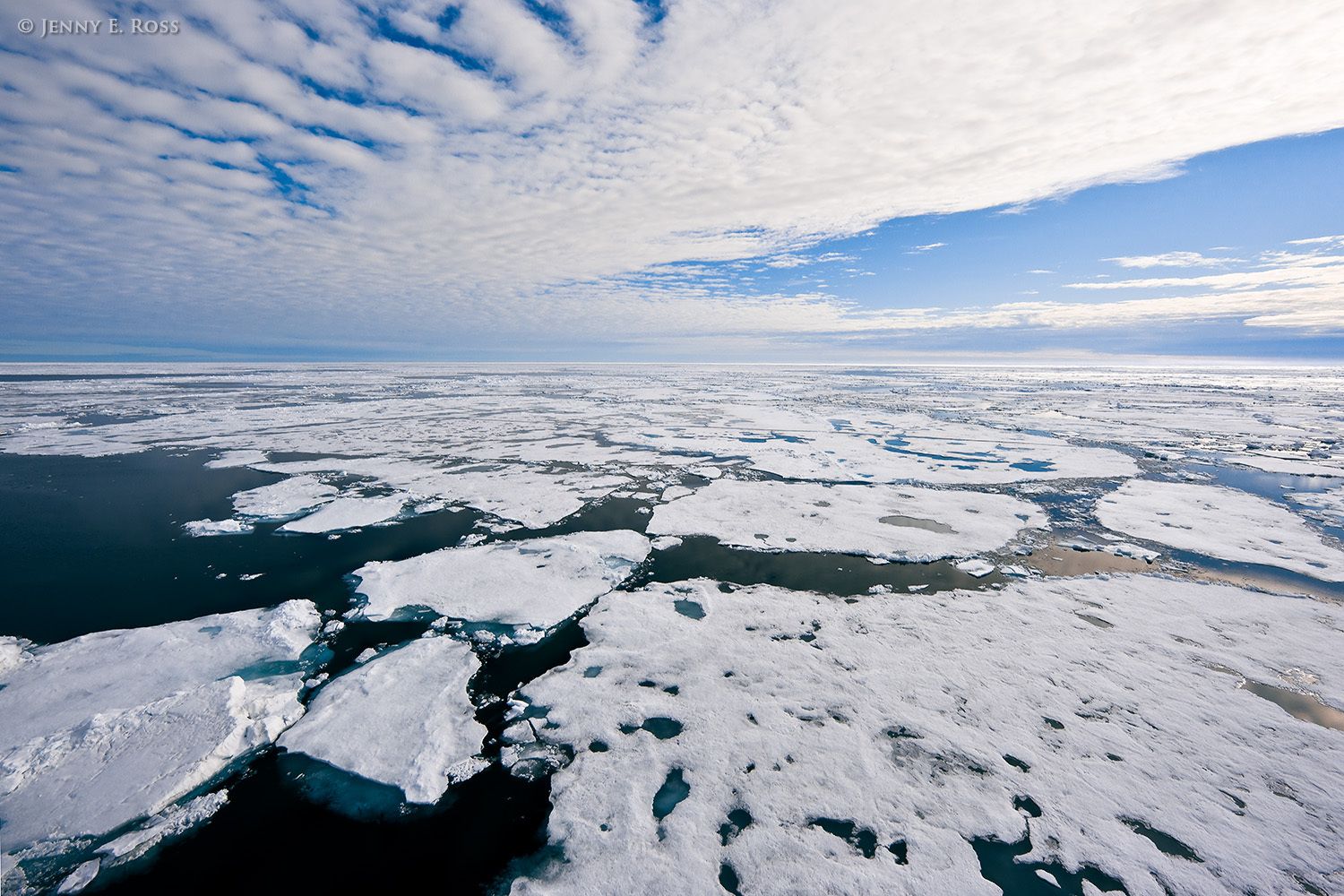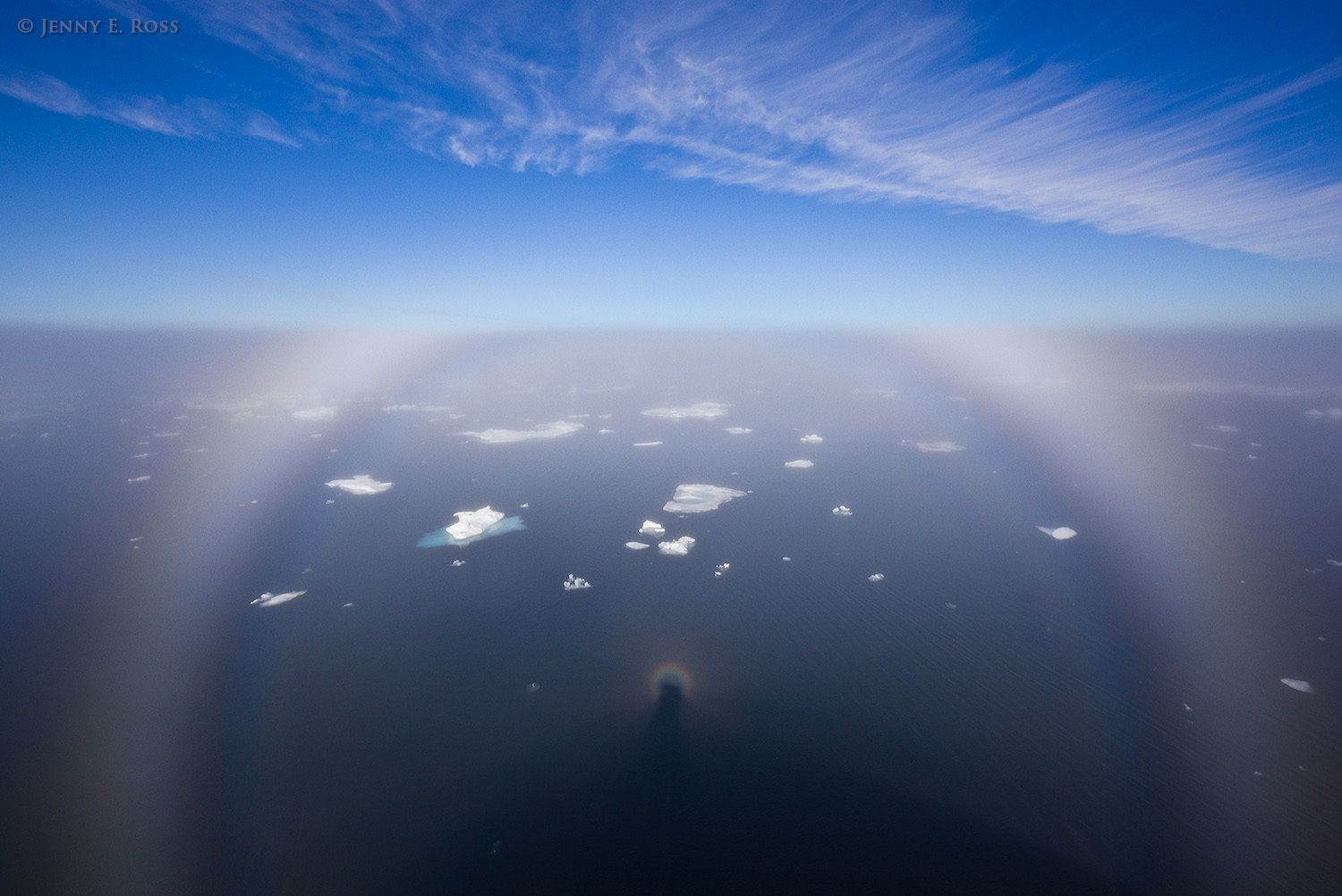-
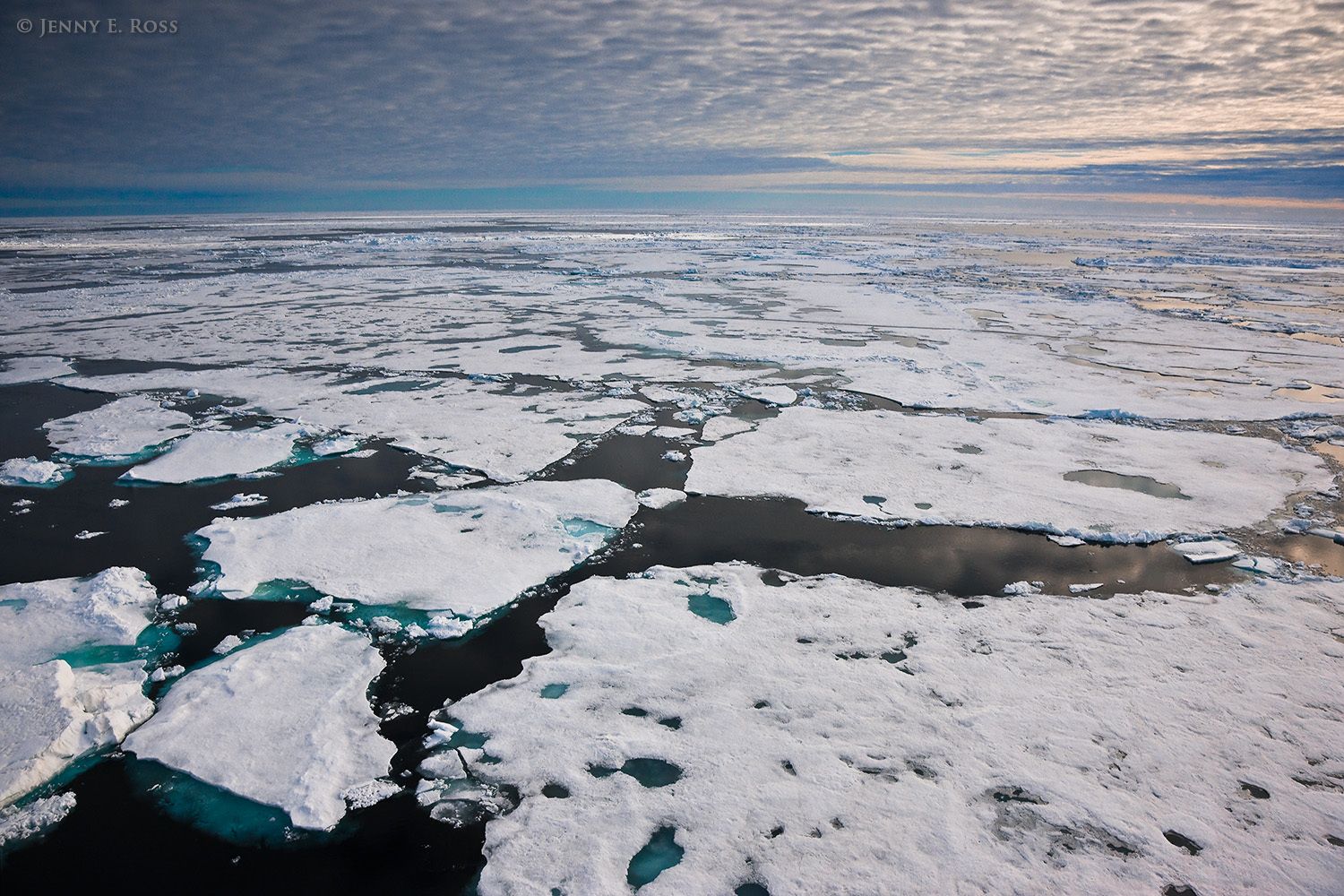
Melting Arctic sea ice in summer
In the Arctic Ocean near 82.5-degrees north, sea ice rapidly melts in summer 2012 when it declined to record low extent and volume. The areas of water within floes of white ice are melt ponds of various depths on the surface of the sea ice. Lines of broken chunks of ice within floes are pressure ridges.
-
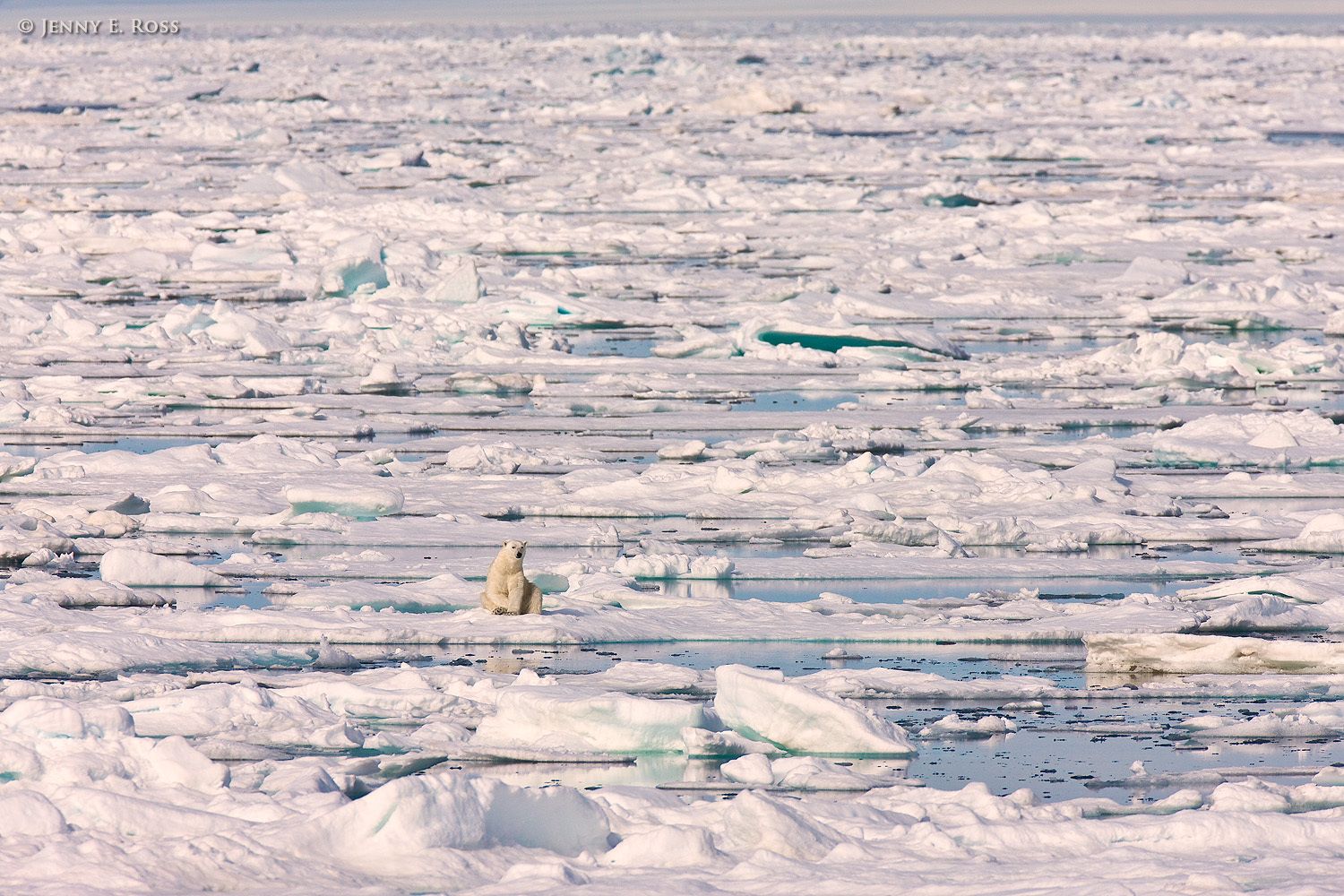
Polar bear resting on melting Arctic sea ice in summer.
Arctic Ocean north of the Svalbard Archipelago.
-
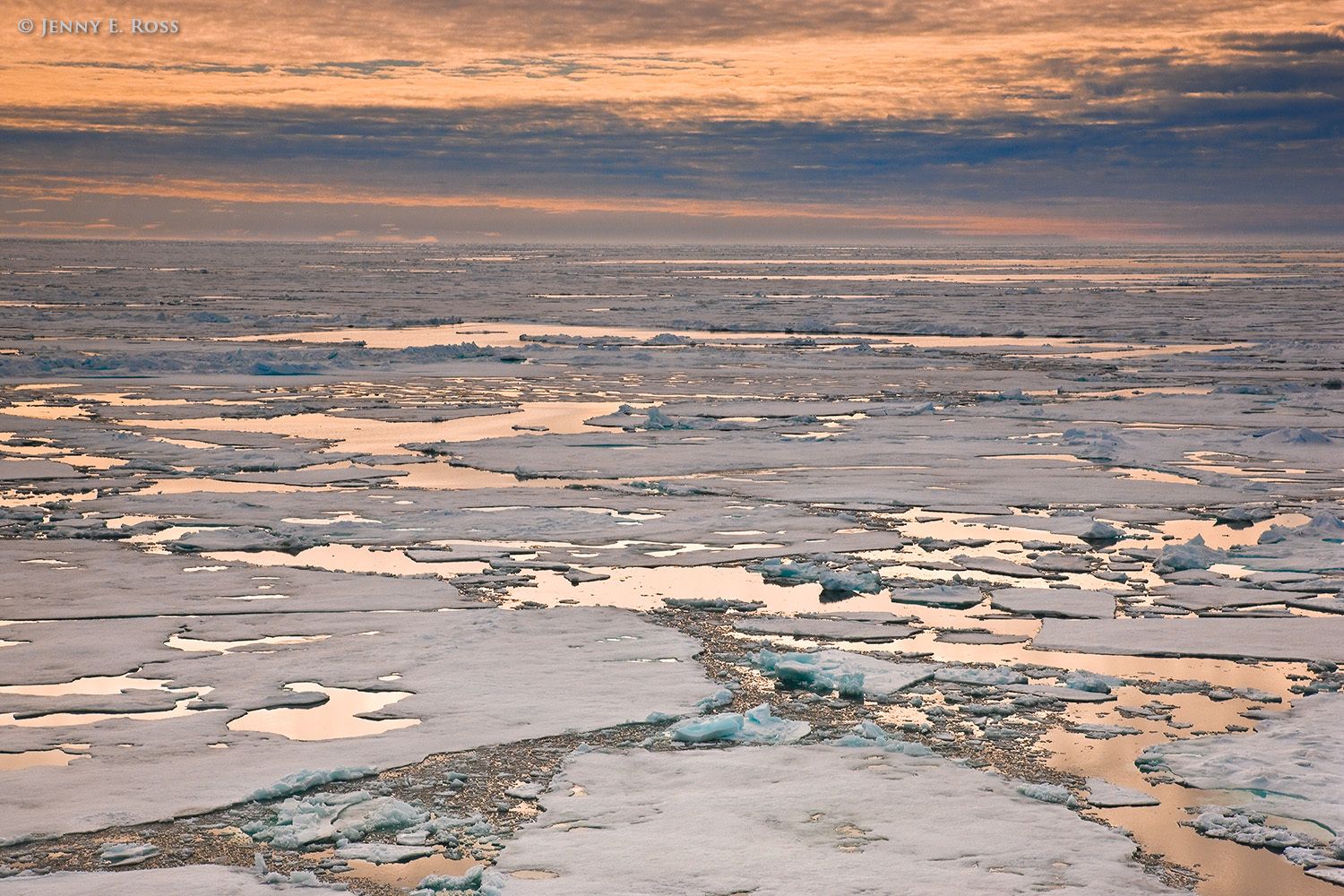
Melting Arctic sea ice in late summer.
Sea ice rapidly melts in the Arctic Ocean near 82.5-degrees north in late summer 2012 as it declined to record low extent and volume. The areas of water within floes of white ice are melt ponds of various depths on the surface of the sea ice. Lines of broken chunks of ice within floes are pressure ridges.
-
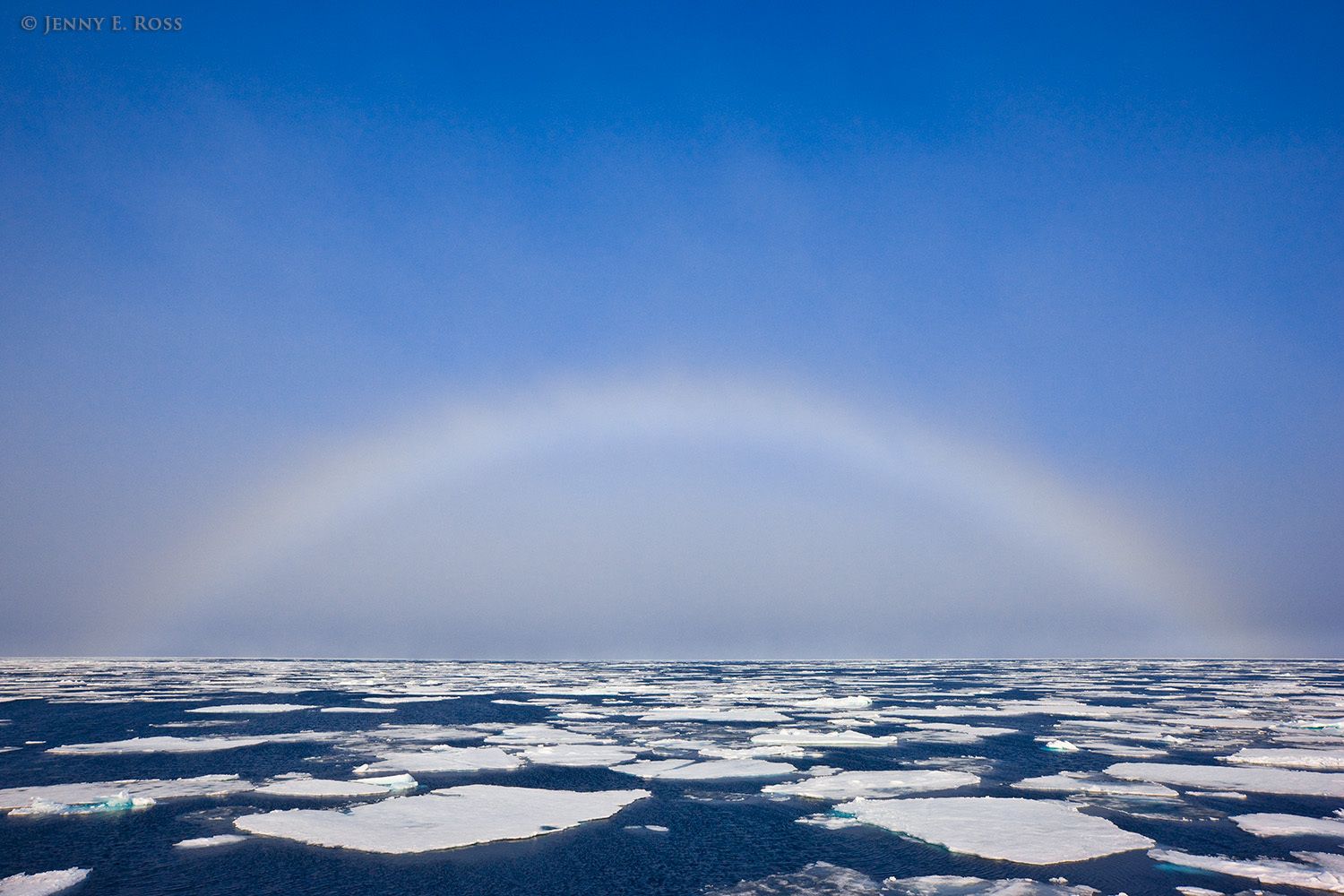
Fog bow above fractured Arctic sea ice near 81 degrees north.
A fog bow arches across the Arctic Ocean, above fractured and melting floes of sea ice. Sunlight shining on disappearing fog created the optical phenomenon. There was only thin and scattered sea ice in this region of the Arctic Ocean north of the Svalbard Archipelago in late July, at a location near 81 degrees North -- far less ice than has covered the region historically.
-
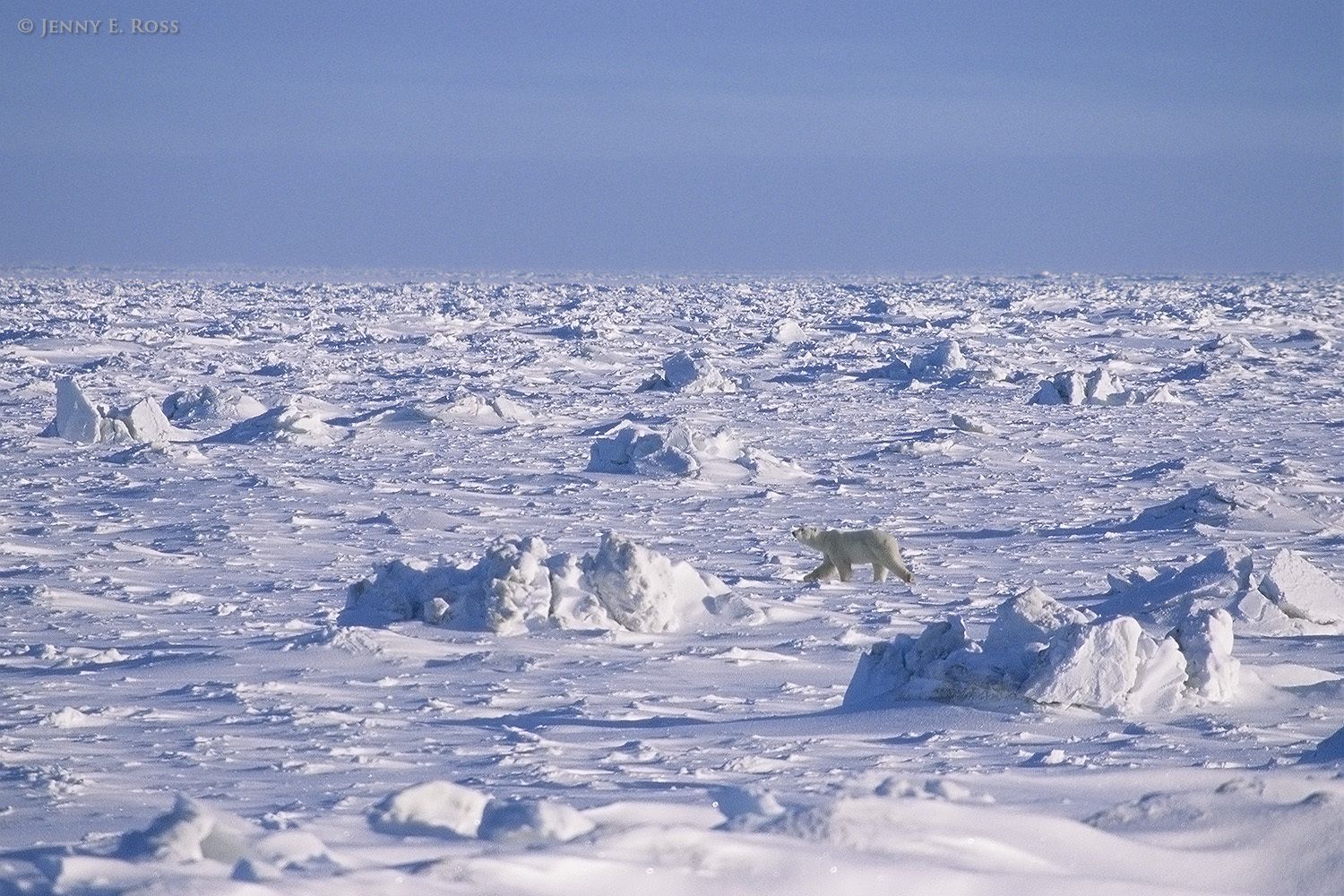
Polar bear walking on sea ice
In early winter, a young adult male polar bear (Ursus maritimus) walks on sea ice dotted with jagged pressure ridges in Hudson Bay, Manitoba, Canada.
-
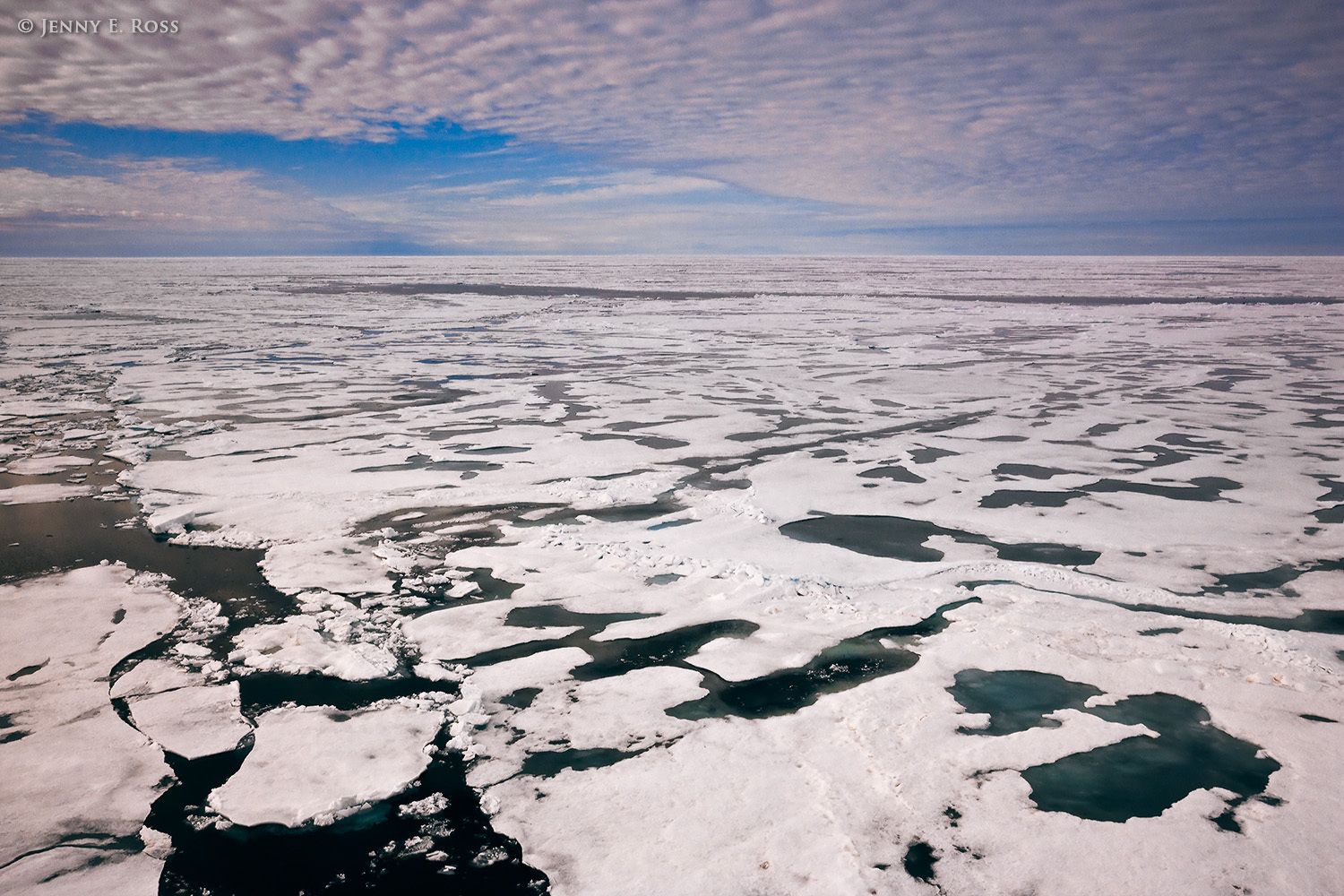
Melting Arctic sea ice in summer.
In the Arctic Ocean near 82.5-degrees north, sea ice rapidly melts in summer 2012 when it declined to record low extent and volume. The areas of water within floes of white ice are melt ponds of various depths on the surface of the sea ice. Lines of broken chunks of ice within floes are pressure ridges.
-
![Sea ice rapidly melts in the Arctic Ocean near 82.5 degrees north during summer 2012 when it declined to record low extent and volume. The areas of water within floes of white ice are melt ponds of various depths on the surface of the sea ice. Lines of broken chunks of ice within floes are pressure ridges. Melting Arctic sea ice in summer.]()
Melting Arctic sea ice in summer.
Sea ice rapidly melts in the Arctic Ocean near 82.5 degrees north during summer 2012 when it declined to record low extent and volume. The areas of water within floes of white ice are melt ponds of various depths on the surface of the sea ice. Lines of broken chunks of ice within floes are pressure ridges.
-
![A Harp Seal (Pagophilus groenlandicus) mother with her "white-coat" pup, rest on the sea ice where the young pup was born. All species of Arctic seals require sea ice for giving birth, rearing young, resting, and molting; their continued survival is therefore threatened by climate change and the melting of Arctic sea ice. The pup is less than 15 days old. Harp seal pups can be hunted in Canada after they have lost their white fur and are more than 15 days old. Harp seals are also called "saddleback seals" due to the dark marking that looks like a saddle. Harp Seal mother & pup resting on Arctic sea ice in the Gulf of St. Lawrence, Nova Scotia, Canada.]()
Harp Seal mother & pup resting on Arctic sea ice in the Gulf of St. Lawrence, Nova Scotia, Canada.
A Harp Seal (Pagophilus groenlandicus) mother with her "white-coat" pup, rest on the sea ice where the young pup was born. All species of Arctic seals require sea ice for giving birth, rearing young, resting, and molting; their continued survival is therefore threatened by climate change and the melting of Arctic sea ice. The pup is less than 15 days old. Harp seal pups can be hunted in Canada after they have lost their white fur and are more than 15 days old. Harp seals are also called "saddleback seals" due to the dark marking that looks like a saddle.
-
![Fractured summer sea ice in the Arctic Ocean north of the Svalbard Archipelago, near 81 degrees north.]()
Fractured summer sea ice in the Arctic Ocean north of the Svalbard Archipelago, near 81 degrees north.
-
![In the Arctic Ocean near 82.5-degrees north, the sea ice melts rapidly during summer 2012 when it declined to record low extent and volume. The areas of water within floes of white ice are melt ponds of various depths on the surface of the sea ice. Lines of broken chunks of ice within floes are pressure ridges. Melting Arctic sea ice in summer.]()
Melting Arctic sea ice in summer.
In the Arctic Ocean near 82.5-degrees north, the sea ice melts rapidly during summer 2012 when it declined to record low extent and volume. The areas of water within floes of white ice are melt ponds of various depths on the surface of the sea ice. Lines of broken chunks of ice within floes are pressure ridges.
-
![In the Arctic Ocean near 82.5-degrees north, sea ice melts rapidly in late summer 2012 as it declines to record low extent and volume. The areas of water within floes of white ice are melt ponds of various depths on the surface of the sea ice. Lines of broken chunks of ice within floes are pressure ridges. Melting Arctic sea ice in late summer.]()
Melting Arctic sea ice in late summer.
In the Arctic Ocean near 82.5-degrees north, sea ice melts rapidly in late summer 2012 as it declines to record low extent and volume. The areas of water within floes of white ice are melt ponds of various depths on the surface of the sea ice. Lines of broken chunks of ice within floes are pressure ridges.
-
![Melting Arctic sea ice in summer, in the Arctic Ocean near 82.5-degrees north. Lines of broken chunks of ice are pressure ridges in the floes. The areas of water are melt ponds of various depths on the surface of the sea ice. Some of the melt ponds have melted all the way through to the ocean water below. The ocean depth at this location was about 3500-4000 meters. Melting Arctic sea ice in summer]()
Melting Arctic sea ice in summer
Melting Arctic sea ice in summer, in the Arctic Ocean near 82.5-degrees north. Lines of broken chunks of ice are pressure ridges in the floes. The areas of water are melt ponds of various depths on the surface of the sea ice. Some of the melt ponds have melted all the way through to the ocean water below. The ocean depth at this location was about 3500-4000 meters.
-
![During a research expedition in the Arctic Ocean, Norwegian Polar Institute scientists assess sea ice thickness using an airborne instrument called the EM-Bird, a large torpedo-shaped scientific device that hangs from a helicopter. As the helicopter flies transects above the sea ice, the electromagnetic and laser sensors in the EM-Bird collect data that can then be used to calculate the thickness of the ice. This work was conducted near 82.5-degrees north / 21-degrees east as part of NPI's 2012 "ICE" (Ice, Climate, and Ecosystems) expedition in July-August 2012. Research on sea ice in the Arctic Ocean]()
Research on sea ice in the Arctic Ocean
During a research expedition in the Arctic Ocean, Norwegian Polar Institute scientists assess sea ice thickness using an airborne instrument called the EM-Bird, a large torpedo-shaped scientific device that hangs from a helicopter. As the helicopter flies transects above the sea ice, the electromagnetic and laser sensors in the EM-Bird collect data that can then be used to calculate the thickness of the ice. This work was conducted near 82.5-degrees north / 21-degrees east as part of NPI's 2012 "ICE" (Ice, Climate, and Ecosystems) expedition in July-August 2012.
-
![A polar bear mother (on right) and her twin cubs (probably 2.5 years old) rest on a floe of sea ice in heavy fog at twilight, in the Arctic Ocean above 81-degrees north. Polar bear mother and twin two-year-old cubs resting on sea ice.]()
Polar bear mother and twin two-year-old cubs resting on sea ice.
A polar bear mother (on right) and her twin cubs (probably 2.5 years old) rest on a floe of sea ice in heavy fog at twilight, in the Arctic Ocean above 81-degrees north.
-
![Melting Arctic sea ice north of Spitsbergen, near 81-degrees north. Svalbard Archipelago, Norway. Melting Arctic sea ice in summer.]()
Melting Arctic sea ice in summer.
Melting Arctic sea ice north of Spitsbergen, near 81-degrees north. Svalbard Archipelago, Norway.
-
![An adult female harp seal (Pagophilus groenlandicus) surfaces in a breathing hole she has maintained in the floating pack ice of the Gulf of St. Lawrence, near where her young pup is resting on the ice. All species of Arctic seals require sea ice for resting, molting, giving birth and rearing young. Harp seal surfacing in a breathing hole, Gulf of St. Lawrence, Nova Scotia, Canada.]()
Harp seal surfacing in a breathing hole, Gulf of St. Lawrence, Nova Scotia, Canada.
An adult female harp seal (Pagophilus groenlandicus) surfaces in a breathing hole she has maintained in the floating pack ice of the Gulf of St. Lawrence, near where her young pup is resting on the ice. All species of Arctic seals require sea ice for resting, molting, giving birth and rearing young.
-
![Aerial photograph of the ice conditions between Prince Edward Island and the Magdalen Islands in the Gulf of St. Lawrence, Nova Scotia. Due to warm ambient temperatures during the winter of 2005-2006, sea ice in the Gulf of St. Lawrence was sparse, thin, and highly fractured, and there were large areas of open water. Arctic sea ice, Gulf of St. Lawrence, Canada.]()
Arctic sea ice, Gulf of St. Lawrence, Canada.
Aerial photograph of the ice conditions between Prince Edward Island and the Magdalen Islands in the Gulf of St. Lawrence, Nova Scotia. Due to warm ambient temperatures during the winter of 2005-2006, sea ice in the Gulf of St. Lawrence was sparse, thin, and highly fractured, and there were large areas of open water.
-
![Aerial photograph of the ice conditions between Prince Edward Island and the Magdalen Islands in the Gulf of St. Lawrence, Nova Scotia. Due to warm ambient temperatures during the winter of 2005-2006, sea ice in the Gulf of St. Lawrence was sparse, thin, and highly fractured, and there were large areas of open water. Thin fractured Arctic sea ice, Gulf of St. Lawrence, Canada.]()
Thin fractured Arctic sea ice, Gulf of St. Lawrence, Canada.
Aerial photograph of the ice conditions between Prince Edward Island and the Magdalen Islands in the Gulf of St. Lawrence, Nova Scotia. Due to warm ambient temperatures during the winter of 2005-2006, sea ice in the Gulf of St. Lawrence was sparse, thin, and highly fractured, and there were large areas of open water.
-
![Aerial photograph of the ice conditions between Prince Edward Island and the Magdalen Islands in the Gulf of St. Lawrence, Nova Scotia. Due to warm ambient temperatures during the winter of 2005-2006, sea ice in the Gulf of St. Lawrence was sparse, thin, and highly fractured, and there were large areas of open water. Thin fractured Arctic sea ice, Gulf of St. Lawrence, Canada]()
Thin fractured Arctic sea ice, Gulf of St. Lawrence, Canada
Aerial photograph of the ice conditions between Prince Edward Island and the Magdalen Islands in the Gulf of St. Lawrence, Nova Scotia. Due to warm ambient temperatures during the winter of 2005-2006, sea ice in the Gulf of St. Lawrence was sparse, thin, and highly fractured, and there were large areas of open water.
-
![Aerial photograph of the ice conditions between Prince Edward Island and the Magdalen Islands in the Gulf of St. Lawrence, Nova Scotia. Due to warm ambient temperatures during the winter of 2005-2006, sea ice in the Gulf of St. Lawrence was sparse, thin, and highly fractured, and there were large areas of open water. Thin fractured Arctic sea ice, Gulf of St. Lawrence]()
Thin fractured Arctic sea ice, Gulf of St. Lawrence
Aerial photograph of the ice conditions between Prince Edward Island and the Magdalen Islands in the Gulf of St. Lawrence, Nova Scotia. Due to warm ambient temperatures during the winter of 2005-2006, sea ice in the Gulf of St. Lawrence was sparse, thin, and highly fractured, and there were large areas of open water.
-
![In the Arctic Ocean near 82.5-degrees north, sea ice melts rapidly as it declines to record low extent and volume. The areas of water within floes of white ice are melt ponds of various depths on the surface of the sea ice. Lines of broken chunks of ice within floes are pressure ridges. Melting Arctic sea ice in late summer]()
Melting Arctic sea ice in late summer
In the Arctic Ocean near 82.5-degrees north, sea ice melts rapidly as it declines to record low extent and volume. The areas of water within floes of white ice are melt ponds of various depths on the surface of the sea ice. Lines of broken chunks of ice within floes are pressure ridges.
-
![Norwegian Polar Institute scientists hike on the sea ice as they conduct research in the Arctic Ocean during NPI's 2012 "ICE" (Ice, Climate, and Ecosystems) expedition in July-August 2012. The areas of water are shallow melt ponds of varying depth on the surface of the ice floe. The line of broken ice chunks across the central portion of the image is a pressure ridge in the floe. Scientific research on Arctic sea ice, central polar basin, Arctic Ocean.]()
Scientific research on Arctic sea ice, central polar basin, Arctic Ocean.
Norwegian Polar Institute scientists hike on the sea ice as they conduct research in the Arctic Ocean during NPI's 2012 "ICE" (Ice, Climate, and Ecosystems) expedition in July-August 2012. The areas of water are shallow melt ponds of varying depth on the surface of the ice floe. The line of broken ice chunks across the central portion of the image is a pressure ridge in the floe.
-
![The Norwegian Polar Institute's research ship "RV Lance" lies at anchor in the Arctic sea ice near 82.5 degrees north during NPI's ICE ("Ice, Climate, and Ecosystems") expedition in July - August 2012. The ship was attached securely to the floe of ice on the left side of the photograph, and the vessel moved with the floe as the ice floated freely in the ocean, for the duration of various on-ice, above-ice, and under-ice scientific research activities. Scientific research on Arctic sea ice, central polar basin, Arctic Ocean.]()
Scientific research on Arctic sea ice, central polar basin, Arctic Ocean.
The Norwegian Polar Institute's research ship "RV Lance" lies at anchor in the Arctic sea ice near 82.5 degrees north during NPI's ICE ("Ice, Climate, and Ecosystems") expedition in July - August 2012. The ship was attached securely to the floe of ice on the left side of the photograph, and the vessel moved with the floe as the ice floated freely in the ocean, for the duration of various on-ice, above-ice, and under-ice scientific research activities.
-
![In the Arctic Ocean near 82.5-degrees north, sea ice melts rapidly as it declines to record low extent and volume. The areas of water within floes of white ice are melt ponds of various depths on the surface of the sea ice. Lines of broken chunks of ice within floes are pressure ridges. Melting Arctic sea ice in summer.]()
Melting Arctic sea ice in summer.
In the Arctic Ocean near 82.5-degrees north, sea ice melts rapidly as it declines to record low extent and volume. The areas of water within floes of white ice are melt ponds of various depths on the surface of the sea ice. Lines of broken chunks of ice within floes are pressure ridges.
-
![Norwegian Polar Institute scientific divers prepare for research activities on a large floe of sea ice in the Arctic Ocean near 82.5 degrees north during NPI's 2012 "ICE" (Ice, Climate, Ecosystems) expedition in July-August 2012. (The divers are: Haakon Hop (standing right), Rupert Krapp (sitting right), Peter Leopold (standing left), and Michal Tessmann (sitting left). Scientific research on Arctic sea ice, central polar basin, Arctic Ocean.]()
Scientific research on Arctic sea ice, central polar basin, Arctic Ocean.
Norwegian Polar Institute scientific divers prepare for research activities on a large floe of sea ice in the Arctic Ocean near 82.5 degrees north during NPI's 2012 "ICE" (Ice, Climate, Ecosystems) expedition in July-August 2012. (The divers are: Haakon Hop (standing right), Rupert Krapp (sitting right), Peter Leopold (standing left), and Michal Tessmann (sitting left).
-
![Norwegian Polar Institute ICE technician Jago Wallenschus prepares zooplankton samples for laboratory analysis. The zooplankton were collected beneath the sea ice in the Arctic Ocean by NPI scientific divers during NPI's 2012 "ICE" (Ice, Climate, Ecosystems) expedition in July-August 2012. Scientific research on Arctic sea ice, central polar basin, Arctic Ocean.]()
Scientific research on Arctic sea ice, central polar basin, Arctic Ocean.
Norwegian Polar Institute ICE technician Jago Wallenschus prepares zooplankton samples for laboratory analysis. The zooplankton were collected beneath the sea ice in the Arctic Ocean by NPI scientific divers during NPI's 2012 "ICE" (Ice, Climate, Ecosystems) expedition in July-August 2012.
-
![During a research expedition in the Arctic Ocean, Norwegian Polar Institute scientist Angelika Renner, a physical oceanographer and sea ice physicist, uses an electromagnetic instrument to collect data that will be used to calculate the thickness of the sea ice. The device is an EM-31, a ground-based version of the airborne EM-Bird instrument. This work was conducted on a large floe of melting summer sea ice in the Arctic Ocean as part of NPI's 2012 "ICE" (Ice, Climate, and Ecosystems) expedition in July-August 2012. Scientific research on Arctic sea ice, central polar basin, Arctic Ocean.]()
Scientific research on Arctic sea ice, central polar basin, Arctic Ocean.
During a research expedition in the Arctic Ocean, Norwegian Polar Institute scientist Angelika Renner, a physical oceanographer and sea ice physicist, uses an electromagnetic instrument to collect data that will be used to calculate the thickness of the sea ice. The device is an EM-31, a ground-based version of the airborne EM-Bird instrument. This work was conducted on a large floe of melting summer sea ice in the Arctic Ocean as part of NPI's 2012 "ICE" (Ice, Climate, and Ecosystems) expedition in July-August 2012.
-
![Norwegian Polar Institute sea ice scientists Christina Pedersen and Dmitry Divine make measurements of ice surface topography using a laser device on a large floe of sea ice in the Arctic Ocean during NPI's 2012 "ICE" (Ice, Climate, and Ecosystems) expedition. The areas of blue water are melt ponds of varying depth on the surface of the ice floe. Scientific research on Arctic sea ice, central polar basin, Arctic Ocean.]()
Scientific research on Arctic sea ice, central polar basin, Arctic Ocean.
Norwegian Polar Institute sea ice scientists Christina Pedersen and Dmitry Divine make measurements of ice surface topography using a laser device on a large floe of sea ice in the Arctic Ocean during NPI's 2012 "ICE" (Ice, Climate, and Ecosystems) expedition. The areas of blue water are melt ponds of varying depth on the surface of the ice floe.
-
![A large melt pond has formed on disintegrating Arctic sea ice north of the Svalbard Archipelago, Norway. Melting Arctic sea ice near 81-degrees north.]()
Melting Arctic sea ice near 81-degrees north.
A large melt pond has formed on disintegrating Arctic sea ice north of the Svalbard Archipelago, Norway.
-
![A lumpy aggregation of various species of ice algae and plankton floats underwater suspended at the interface between fresh sea-ice meltwater and saline ocean water. At a time in the summer when Arctic sea ice had undergone significant melting and was continuing to deteriorate, large numbers of such algal aggregates were discovered during a sea-ice research expedition by Norwegian Polar Institute scientists within the sea ice north of Svalbard in the Arctic Ocean near 82-degrees north. A lumpy aggregation of ice algae and plankton floating in the Arctic Ocean.]()
A lumpy aggregation of ice algae and plankton floating in the Arctic Ocean.
A lumpy aggregation of various species of ice algae and plankton floats underwater suspended at the interface between fresh sea-ice meltwater and saline ocean water. At a time in the summer when Arctic sea ice had undergone significant melting and was continuing to deteriorate, large numbers of such algal aggregates were discovered during a sea-ice research expedition by Norwegian Polar Institute scientists within the sea ice north of Svalbard in the Arctic Ocean near 82-degrees north.
-
![Lumpy aggregations of various species of ice algae and plankton float underwater suspended at the interface between fresh sea-ice meltwater and saline ocean water. At a time in the summer when Arctic sea ice had undergone significant melting and was continuing to deteriorate, large numbers of such algal aggregates were discovered during a sea-ice research expedition by Norwegian Polar Institute scientists within the sea ice north of Svalbard in the Arctic Ocean near 82-degrees north. Lumpy aggregations of ice algae and plankton, floating in the Arctic Ocean]()
Lumpy aggregations of ice algae and plankton, floating in the Arctic Ocean
Lumpy aggregations of various species of ice algae and plankton float underwater suspended at the interface between fresh sea-ice meltwater and saline ocean water. At a time in the summer when Arctic sea ice had undergone significant melting and was continuing to deteriorate, large numbers of such algal aggregates were discovered during a sea-ice research expedition by Norwegian Polar Institute scientists within the sea ice north of Svalbard in the Arctic Ocean near 82-degrees north.
-
![Lumpy aggregations of various species of ice algae and plankton float underwater suspended at the interface between fresh sea-ice meltwater and saline ocean water. At a time in the summer when Arctic sea ice had undergone significant melting and was continuing to deteriorate, large numbers of such algal aggregates were discovered during a sea-ice research expedition by Norwegian Polar Institute scientists within the sea ice north of Svalbard in the Arctic Ocean near 82-degrees north. Aggregations of ice algae and plankton floating in the Arctic Ocean.]()
Aggregations of ice algae and plankton floating in the Arctic Ocean.
Lumpy aggregations of various species of ice algae and plankton float underwater suspended at the interface between fresh sea-ice meltwater and saline ocean water. At a time in the summer when Arctic sea ice had undergone significant melting and was continuing to deteriorate, large numbers of such algal aggregates were discovered during a sea-ice research expedition by Norwegian Polar Institute scientists within the sea ice north of Svalbard in the Arctic Ocean near 82-degrees north.
-
![Lumpy aggregations of various species of ice algae and plankton float underwater suspended at the interface between fresh sea-ice meltwater and saline ocean water. At a time in the summer when Arctic sea ice had undergone significant melting and was continuing to deteriorate, large numbers of such algal aggregates were discovered during a sea-ice research expedition by Norwegian Polar Institute scientists within the sea ice north of Svalbard in the Arctic Ocean near 82-degrees north. Aggregations of ice algae and plankton, floating in the Arctic Ocean]()
Aggregations of ice algae and plankton, floating in the Arctic Ocean
Lumpy aggregations of various species of ice algae and plankton float underwater suspended at the interface between fresh sea-ice meltwater and saline ocean water. At a time in the summer when Arctic sea ice had undergone significant melting and was continuing to deteriorate, large numbers of such algal aggregates were discovered during a sea-ice research expedition by Norwegian Polar Institute scientists within the sea ice north of Svalbard in the Arctic Ocean near 82-degrees north.
-
![Lumpy aggregations of various species of ice algae and plankton float underwater suspended at the interface between fresh sea-ice meltwater and saline ocean water. At a time in the summer when Arctic sea ice had undergone significant melting and was continuing to deteriorate, large numbers of such algal aggregates were discovered during a sea-ice research expedition by Norwegian Polar Institute scientists within the sea ice north of Svalbard in the Arctic Ocean near 82-degrees north. Aggregations of ice algae and plankton, floating in the Arctic Ocean]()
Aggregations of ice algae and plankton, floating in the Arctic Ocean
Lumpy aggregations of various species of ice algae and plankton float underwater suspended at the interface between fresh sea-ice meltwater and saline ocean water. At a time in the summer when Arctic sea ice had undergone significant melting and was continuing to deteriorate, large numbers of such algal aggregates were discovered during a sea-ice research expedition by Norwegian Polar Institute scientists within the sea ice north of Svalbard in the Arctic Ocean near 82-degrees north.
-
![In the Arctic Ocean near 82.5-degrees north, sea melts rapidly as it declines to record low extent and volume. The areas of water within floes of white ice are melt ponds of various depths on the surface of the sea ice. Lines of broken chunks of ice within floes are pressure ridges. Melting Arctic sea ice in late summer]()
Melting Arctic sea ice in late summer
In the Arctic Ocean near 82.5-degrees north, sea melts rapidly as it declines to record low extent and volume. The areas of water within floes of white ice are melt ponds of various depths on the surface of the sea ice. Lines of broken chunks of ice within floes are pressure ridges.
-
![A polar bear mother and her twin cubs of the year (about 6 months old) travel and hunt on the sea ice near 83-degrees North in the Arctic Ocean's central polar basin. Polar bear mother & twin cubs on sea ice in the Arctic Ocean's central polar basin]()
Polar bear mother & twin cubs on sea ice in the Arctic Ocean's central polar basin
A polar bear mother and her twin cubs of the year (about 6 months old) travel and hunt on the sea ice near 83-degrees North in the Arctic Ocean's central polar basin.
-
![Arctic sea ice melts rapidly in the Arctic Ocean near 82.5 degrees north during summer 2012 as it declines to record low extent and volume. The gray areas are melt ponds of various depths on the surface of the sea ice. This floe exemplifies what is known as "rotten ice" -- sea ice that appears intact and dense when viewed on the surface, but which is riddled with extensive honey-combed decaying ice in a very advanced stage of melt on the underside. Melting Arctic sea ice in summer, central polar basin, Arctic Ocean.]()
Melting Arctic sea ice in summer, central polar basin, Arctic Ocean.
Arctic sea ice melts rapidly in the Arctic Ocean near 82.5 degrees north during summer 2012 as it declines to record low extent and volume. The gray areas are melt ponds of various depths on the surface of the sea ice. This floe exemplifies what is known as "rotten ice" -- sea ice that appears intact and dense when viewed on the surface, but which is riddled with extensive honey-combed decaying ice in a very advanced stage of melt on the underside.
-
![Arctic sea ice melts rapidly in the Arctic Ocean near 82.5 degrees north during summer 2012 as it declines to record low extent and volume. The gray areas are melt ponds of various depths on the surface of the sea ice. This floe exemplifies what is known as "rotten ice" -- sea ice that appears intact and dense when viewed on the surface, but which is riddled with extensive honey-combed decaying ice in a very advanced stage of melt on the underside. Melting Arctic sea ice in summer, central polar basin, Arctic Ocean.]()
Melting Arctic sea ice in summer, central polar basin, Arctic Ocean.
Arctic sea ice melts rapidly in the Arctic Ocean near 82.5 degrees north during summer 2012 as it declines to record low extent and volume. The gray areas are melt ponds of various depths on the surface of the sea ice. This floe exemplifies what is known as "rotten ice" -- sea ice that appears intact and dense when viewed on the surface, but which is riddled with extensive honey-combed decaying ice in a very advanced stage of melt on the underside.
-
![Arctic sea ice melts rapidly in the Arctic Ocean near 82.5 degrees north during summer 2012 as it declines to record low extent and volume. The gray areas are melt ponds of various depths on the surface of the sea ice. This floe exemplifies what is known as "rotten ice" -- sea ice that appears intact and dense when viewed on the surface, but which is riddled with extensive honey-combed decaying ice in a very advanced stage of melt on the underside. Melting Arctic sea ice in summer, central polar basin, Arctic Ocean.]()
Melting Arctic sea ice in summer, central polar basin, Arctic Ocean.
Arctic sea ice melts rapidly in the Arctic Ocean near 82.5 degrees north during summer 2012 as it declines to record low extent and volume. The gray areas are melt ponds of various depths on the surface of the sea ice. This floe exemplifies what is known as "rotten ice" -- sea ice that appears intact and dense when viewed on the surface, but which is riddled with extensive honey-combed decaying ice in a very advanced stage of melt on the underside.
-
![Melting Arctic sea ice north of Spitsbergen, near 81-degrees North. Svalbard Archipelago, Norway. Melting Arctic sea ice in summer.]()
Melting Arctic sea ice in summer.
Melting Arctic sea ice north of Spitsbergen, near 81-degrees North. Svalbard Archipelago, Norway.
-
![In the Arctic Ocean near 82.5-degrees north, sea ice rapidly melts as it declines to record low extent and volume. The areas of water within floes of white ice are melt ponds of various depths on the surface of the sea ice. Lines of broken chunks of ice within floes are pressure ridges. Melting Arctic sea ice in summer, central polar basin, Arctic Ocean..]()
Melting Arctic sea ice in summer, central polar basin, Arctic Ocean..
In the Arctic Ocean near 82.5-degrees north, sea ice rapidly melts as it declines to record low extent and volume. The areas of water within floes of white ice are melt ponds of various depths on the surface of the sea ice. Lines of broken chunks of ice within floes are pressure ridges.
-
![Heavy fog clears from Olgastretet in the Barents Sea (Arctic Ocean) within the Svalbard Archipelago, at a location above 78 degrees north, revealing that there is almost no sea ice in this region at the end of July. Lack of sea ice in the Barents Sea (Arctic Ocean), above 78 degrees north.]()
Lack of sea ice in the Barents Sea (Arctic Ocean), above 78 degrees north.
Heavy fog clears from Olgastretet in the Barents Sea (Arctic Ocean) within the Svalbard Archipelago, at a location above 78 degrees north, revealing that there is almost no sea ice in this region at the end of July.
-
![A fog bow arches across Olgastretet in the Barents Sea, accompanied by a Brocken specter and glory. Sunlight shining on disappearing fog created the optical phenomena. There was almost no sea ice in this region of the Arctic Ocean within the Svalbard Archipelago,at a location above 78 degrees North -- an unusual circumstance in July. Climate change is rapidly shrinking the Arctic sea ice and lengthening the ice-free period in many portions of the Barents Sea and other marginal seas of the Arctic Ocean. Fog Bow, Brocken Specter & Glory in Olgastretet, Barents Sea, Arctic Ocean]()
Fog Bow, Brocken Specter & Glory in Olgastretet, Barents Sea, Arctic Ocean
A fog bow arches across Olgastretet in the Barents Sea, accompanied by a Brocken specter and glory. Sunlight shining on disappearing fog created the optical phenomena. There was almost no sea ice in this region of the Arctic Ocean within the Svalbard Archipelago,at a location above 78 degrees North -- an unusual circumstance in July. Climate change is rapidly shrinking the Arctic sea ice and lengthening the ice-free period in many portions of the Barents Sea and other marginal seas of the Arctic Ocean.
-
![In the Arctic Ocean near 82.5 degrees north, sea ice melts rapidly in summer 2012 as it declines to record low extent and volume. The heavily-textured floe exemplifies what is known as "rotten ice" -- ice that is in an advanced stage of melt, and is riddled with honey-combed decay. The ocean is black due to its depth -- approximately 3500-4000 meters deep at this location within the central polar basin. The image conceptually illustrates the ice-albedo feedback effect: As bright white ice -- which reflects most of the sun's energy -- melts due to rising temperatures, it is replaced by dark open ocean -- which absorbs most of the sun's energy; temperatures rise even more as a consequence, causing more ice to melt. As Earth's climate continues to warm, the downward spiral of this process is expected to continue until summer sea ice disappears annually. Rapidly-melting Arctic sea ice in summer, central polar basin, Arctic Ocean..]()
Rapidly-melting Arctic sea ice in summer, central polar basin, Arctic Ocean..
In the Arctic Ocean near 82.5 degrees north, sea ice melts rapidly in summer 2012 as it declines to record low extent and volume. The heavily-textured floe exemplifies what is known as "rotten ice" -- ice that is in an advanced stage of melt, and is riddled with honey-combed decay. The ocean is black due to its depth -- approximately 3500-4000 meters deep at this location within the central polar basin. The image conceptually illustrates the ice-albedo feedback effect: As bright white ice -- which reflects most of the sun's energy -- melts due to rising temperatures, it is replaced by dark open ocean -- which absorbs most of the sun's energy; temperatures rise even more as a consequence, causing more ice to melt. As Earth's climate continues to warm, the downward spiral of this process is expected to continue until summer sea ice disappears annually.
-
![In the Arctic Ocean near 82.5 degrees north, sea ice melts rapidly in summer 2012 as it declines to record low extent and volume. The heavily-textured floe exemplifies what is known as "rotten ice" -- ice that is in an advanced stage of melt, and is riddled with honey-combed decay. The ocean is black due to its depth -- approximately 3500-4000 meters deep at this location within the central polar basin. The image conceptually illustrates the ice-albedo feedback effect: As bright white ice -- which reflects most of the sun's energy -- melts due to rising temperatures, it is replaced by dark open ocean -- which absorbs most of the sun's energy; temperatures rise even more as a consequence, causing more ice to melt. As Earth's climate continues to warm, the downward spiral of this process is expected to continue until summer sea ice disappears annually. Rapidly-melting Arctic sea ice in summer, central polar basin, Arctic Ocean.]()
Rapidly-melting Arctic sea ice in summer, central polar basin, Arctic Ocean.
In the Arctic Ocean near 82.5 degrees north, sea ice melts rapidly in summer 2012 as it declines to record low extent and volume. The heavily-textured floe exemplifies what is known as "rotten ice" -- ice that is in an advanced stage of melt, and is riddled with honey-combed decay. The ocean is black due to its depth -- approximately 3500-4000 meters deep at this location within the central polar basin. The image conceptually illustrates the ice-albedo feedback effect: As bright white ice -- which reflects most of the sun's energy -- melts due to rising temperatures, it is replaced by dark open ocean -- which absorbs most of the sun's energy; temperatures rise even more as a consequence, causing more ice to melt. As Earth's climate continues to warm, the downward spiral of this process is expected to continue until summer sea ice disappears annually.















